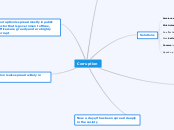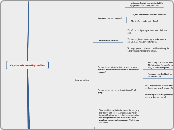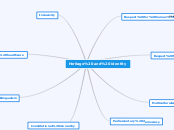Floating topic
CANADA SINCE WORLD WAR
UNIT 4- CANADA IN THE MODERN ERA
FEDERALISM VS SEPARATISM
Bill 101 annihilates the English language in Quebec.
Quebec attempts to separate twice — in 1980 and 1995.
Quebec did not join the Constitution or the Charter of Rights and Liberties (1982) The Meech Lake and Charlottetown Accords attempt to include Quebec into the constitution (both failed). According to the Clarity Act, Canada has the authority to decide whether or not a province can secede.
THE RISE OF SEPARATISM
Pearson attempts to resolve the French-English problem through the “Royal Commission for Bilingualism and Biculturalism,” as well as the new flag. Trudeau makes Canada bilingual, but his “Just Society” concept enrages Quebec. The FLQ is a French Canadian terrorist group. When Members of parliament are kidnapped during the October Crisis, Trudeau invokes the War Measures Act to put an end to it. The FLQ is no longer active, although separatism persists.
FRENCH- ENGLISH RELATIONS
Maurice Duplessis and the Union Nationale ruled Quebec from 1944 to 1969.
Duplessis attempted to foster French Canadian nationalism by opposing all federal government intervention in Quebec matters. Duplessis was seen as Quebec's defender against Communism.
Duplessis retained power through forming alliances with the Catholic Church and promoting a more agricultural society. He encouraged English and foreign investment in Quebec while teaching French Canadians to distrust technology and appreciate rural life.
QUEBEC'S QUIET REVOLUTION
Maurice Duplessis - La Survivance (Survival) preserved Quebec traditional — Quebec lagged behind the rest of Canada. Jean Lesage - Maitre Chez Nous (masters in our own home) modifies Quebec, achieving equality with Canada's Quiet Revolution — Quebec becomes less Catholic, less traditional, more modernized, and politically involved. Vive le Quebec Libre - Long live free Quebec – declared DeGaulle at Expo 67. René Levesque is a model. Rene Levesque starts the Parti Quebecois – dedicated to
seperatism
THE COLD WAR
THE 1950s
Newfoundland has joined Canada Economic. In the 1950s, Canada becomes a "branch plant" of the United States. The Baby Boom generation was born. The first subdivisions of 50s culture are established - TVs, Cars, Fast Food, as well as Rock & Roll. Modern teens are the result of compulsory high school attendance.
CANADA AND THE WORLD
The United nations is replaced by the United Nations.
Almost every country in the world backs the United Nations. Lester Pearson offers a solution to the Suez Canal Crisis. The first “Peacekeepers” in the globe. Ever since, the peacekeepers have worked all around the world. Working to bring world peace and unity , stability to war torn countries.
UNIT 1- WORLD WAR 1
WAR AT SEA AND AIR
Germany was virtually blockaded by the British. The convoy system made it possible for friendly ships to cross the seas securely. The sinking of the Lusitania enraged the United States. Unrestricted Submarine Warfare drew the United States into the conflict. Being a pilot was glamorous, but it was also hazardous. Aces like the Red Baron and Billy Bishop were well-known.
THE ASSASSINATION OF ARCHDUKE FRANI
Archduke was a prince of Imperial family in Austria. The Black Hand was a secret military society formed in 1911. It was instrumental in the planning of assassination of Archduke Ferdinand. Archduke and his pregnant wife, heir to Austria-Hungarian throne, Dutchess Sophie were assassinated on June 18 1914.
CAUSES OF WW1
Militarism- Militarism is the belief of a government that they should maintain a strong army .
Alliance- The alliances have allowed European states to benefit from certain protection. They served to protect or promote national interests.
Nationalism- It brings countries together in some way. Nationalism can use feelings of division to appeal to the public, and therefore to less legitimate government.
Imperialism: Nations were competing for more land, colonies and resources. Britain and Germany are competing on an industrial basis, so they need more commodities.
THE SCHLIEFFEN PLAN WORKS
General Alfred Von Schlieffen thought it was good idea because he thought that France was going to be outnumbered and that the French can moblise their army quickly. April 1914, before the first World War started. When Britain declared war on Germany after Germany’s invasion on Belgium.
TRENCH WARFARE
The living conditions, the deadly living conditions.
CANADA PREPARES FOR WAR
BATTLE OF YPRES
Ypres is a Belgium municipality in the province of West Flanders. This battle was brutal, chlorine gas attacks, 6,000 Canadian dead. Canada's initial place in the war.
SECOND BATTLE OF YPRES:
Canadians, French, British vs Germans. They reinforced a new weapon: Chlorine gas. French soldiers were unprotected, panicked, and fled. Canadians move in to replace injured and fled French: hold time for two days.
BATTLE OF SOMME AND VIMMY RIDGE
April 1917, Canadians vs Germans. The French and British had already tried to take back the ridge but both were unsuccessful. Canadians attacked the German lines after an artillery barrage. Within the first hours of the attack, the Germans were in retreat. A German machine gun emplacement of reinforced concrete on the crest of Vimy Ridge and the Canadians seized it. This battle proved the Canadian Corp was equal to any other military.
BATTLE OF SOMME:
July - November 1916, British attack with a " Barrage ".
Somme offensive was considered by the British to be the " Big Push ". It took several months to achieve what was supposed to take several weeks. Germans survived in deep " bunkers ", barded wire remains. The Somme was the biggest disaster in British history. 58,000 causalities happened in one day.
PASSCHENDAELE AND THE 100 DAYS
Passchendaele = MUD and BLOOD, a very costly and
pointless victory. Operation Michael = A desperate, all-or-nothing attack by Germany. 100 Days = Canada leads the way to victory
RACISM IN WW1
Instead of creating a distinctly Canadian army, Sam Hughes opted to base it after the British Army. He thought that a Canadian army in the British style would fit best into the British Chain of Command. As a result, he aggressively prevented French Canadians and other ethnic minorities from enlisting in the Army. There was no formal policy that discriminated against anyone. Non-white individuals, on the other hand, were simply turned away.
WOMEN IN WW1
Women were supposed to stay at home prior to the conflict. Women who worked were mostly unmarried and could only find employment as teachers, nurses, or secretaries. In addition, women's fashion was quite restricting. Women were supposed to wear long gowns that covered their arms, ankles, and necks at all times. With thousands of young men departing to fight in the war and a large demand for food and war materials, women were encouraged to enter the labour sector. For the first time, women were employed in professions such as bus driving, industrial work, and agricultural labour. Female employees increased factory output and efficiency. Thousands of women also served as nursing sisters overseas.
UNIT 2- THE 20s & 30s
CANADIAN POLITICS
William King was the liberal Prime Minister during most of the 20s. Believed the Depression was a “temporary slump” and that the economy would correct itself if left alone. R.B. Bennett won on the election of 1930 (Conservative) on the promise of “solving” the Depression with government intervention. He was a rich and successful business man. All Bennett’s ideas failed and the depression only worsened.
SOCIAL EFFECTS OF DEPRESSION
Drought, severe heat, grasshopper invasions, dust storms dubbed the "Dust Bowl," and hundreds of farmers abandoning their farms Thousands of people were laid off, and finding employment became nearly difficult, as banks cancelled loans, many lost everything, and those who worked had to accept salary cuts. The majority of individuals did not have enough to eat. Canada had a 27 percent unemployment rate by 1933.
THE GREAT DEPRESSION
INVENTIONS OF 1920s
The majority of Canadians now have electricity in their homes. Many new items were created as a result of WWI's advances in electronics. The majority of gadgets were created to improve the ordinary homeowner's quality of life. For an example, vacuums, telephones, sinks, etc.
THE ROARING 20s
WOMEN IN THE 1920s
Before the 20’s, women had few rights. Women were also expected to conform to very strict social rules. However, WW1 changed women’s roles in society and their perception of themselves. During the 20’s many women, especially young women, refused to go back to the old ways.
UNIT 3- WORLD WAR 2
CANADA ENTERS WW2
World War II began on September 1, 1939, with a coordinated attack on Poland by Germany and the Soviet Union. Germany relied on a new military strategy known as "Blitzkrieg" (lightning war). On September 10, 1939, Canada declares war on Germany. World War II had a significant influence on the development of new technology and altered the way battles are fought today.
A SUMMER CHILL- CANADA DECLARES WAR
The summer of 1919 ended early in Canada, on a cloudy, cold
September 10th. On that Sunday, Canada independently declared war on another country for
the first and only time in its history. At this time the economy was declining and stagnant, unemployment was running from 3% to 18% to 27%, and the Canadians were angry and divided because they had nothing! It took a long time for the nation to move from a period of economic stagnation.
CANADA'S ROLE
The Nazis required supplies and resources to keep the war going, thus victory in the Soviet Union was critical.
From September 14th, 1942 until February 2nd, 1943, Germans and Russians fought for the key Volga River city of Stalingrad. As the Germans gradually seize the city, Russian forces to the north and south surround it, trapping a major portion of the German Army within. Hitler denies the army's plea to free the captive troops.
Instead, the stranded Germans starve to death and finally surrender.
This is seen as a watershed moment in the War.
The Nazis never recovered from this.
Hitler and the Nazis lost the fight, with 500 000 German and other forces dead or captured. By the autumn of 1943, Germany's army had grown to 2.5 million men.
THE TREATY OF VERSAILLES
The Germans tried to negotiate terms to end the war while maintaining their honor. Germany accepts all blame for the war (War Guilt), Germany would pay $32,000,000,000 in reparations, Germany’s military is destroyed (no Aircraft, reduced
Navy, 100,000 man army), Germany lost all colonies, Germany lost almost 20% of its territory (to France, Poland and others).
THE RISE OF HITLER
NAZISM IN THE 1930s
THE RISE OF DICTATORS
Dictators (Franco, Mussolini, Hitler, and others) rise from poverty and dissatisfaction. They employ harsh techniques both at home and against foreign countries. The League of Nations lacks the strength and resolve to resist them. Because these tyrants are not deterred, they become more daring and violent. The inability of the League of Nations to intervene resulted in tyrants gaining so much power that it needed a full-scale war to bring them down. The armies of the Triple Alliance and Triple Entente were matched quite equally.
THE HOLOCAUST
The Holocaust
When Hitler came to power in 1933, he immediately began his war on the Jews.
Boycott on Jewish stores. Book burning ceremonies. Laws excluded Jews from being teachers, doctors, professors, lawyers. Jews did not have the right to vote. Not allowed to use public parks, benches, cafes, swimming pools, or sports fields. Children had to attend schools for Jews only.
Stages of the Holocaust:
Stripping of Rights (Nuremberg Laws)
Segregation (Ghettos)
Concentration Camps
Extermination
Aftermath
EUROPE IN 1944
JAPAN DURING WW2
THE ATOMIC BOMB
Despite fierce Japanese opposition, the United States gradually defeats the Imperial Army, Navy, and Air Force.
Both Canada and the United States discriminate against persons of Japanese ancestry (violence, theft and internment). The “Manhattan Project” develops the world's first nuclear weapons. Little Boy and Fat Man atomic bombs were dropped on Hiroshima and Nagasaki, respectively. The atomic bombs ended World War II, but the consequences of the weapons are still being studied.
JAPANESE INTERNMENT IN CANADA
After the bombing of Pearl Harbour and Japan's association with German People. The British Columbia have had their final straw with the Japanese. They exploded with anger and panic when it came to the Japanese people. Every Japanese Canadian was faced with racism and were put into internment camps.
PEARL HARBOUR









